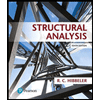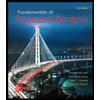
Structural Analysis
6th Edition
ISBN: 9781337630931
Author: KASSIMALI, Aslam.
Publisher: Cengage,
expand_more
expand_more
format_list_bulleted
Concept explainers
Question
![**Consolidation of Clay:**
**Objective:**
Given Exercise Figure 7.4 and accompanying information, determine the ultimate settlement in the clay under the applied load.
**Notes:**
- 1 ft = 0.3048 m
- 62.4 lb/ft³ = 1 Mg/m³
**Formula:**
Assuming the sand will not settle, the ultimate settlement in the clay can be calculated using the formula:
\[
\Delta H = \frac{H}{1 + e_0} C_c \log \left(1 + \frac{\Delta \sigma'}{\sigma'}\right)
\]
**Steps:**
a. **Effective Stress Determination:**
- Determine the effective stress for the cross section prior to loading. Use an appropriate diagram to show stresses at depth.
b. **Calculate \(\Delta \sigma'\):**
- Find the change in effective stress (\(\Delta \sigma'\)) on the clay layer caused by the imposed load. Calculate for the center of the clay layer at 5.8 m [19 ft] deep.
c. **Original Porosity (\(e_0\)):**
- Determine \(e_0\) based on the original porosity of the clay.
d. **Settlement Calculation:**
- Calculate how much settlement will occur in the clay.
**Exercise Figure 7.4: Explanation:**
The figure provides a cross-sectional view with the following layers:
- **0 to 5 ft:** Sand, dry unit weight \(\gamma_d = 105 \, \text{lb/ft}^3\)
- **5 to 16 ft:** Silty sand, saturated unit weight \(\gamma_{\text{sat}} = 127 \, \text{lb/ft}^3\), Groundwater Table (GWT) indicated at 5 ft
- **16 to 22 ft:** Clay, saturated unit weight \(\gamma_{\text{sat}} = 121 \, \text{lb/ft}^3\), with noted porosity (\(n = 0.629\)) and a compression index (\(C_c = 0.82\))
- **Load:** A point load of 125 tons is applied at the surface.
This setup is used to analyze the stress changes and resulting settlement in the clay layer.](https://content.bartleby.com/qna-images/question/8ea503b5-9839-4a05-b482-50f8a035eb54/21edf521-dffa-4368-807c-2b6ded900826/j9v9bhp_thumbnail.png)
Transcribed Image Text:**Consolidation of Clay:**
**Objective:**
Given Exercise Figure 7.4 and accompanying information, determine the ultimate settlement in the clay under the applied load.
**Notes:**
- 1 ft = 0.3048 m
- 62.4 lb/ft³ = 1 Mg/m³
**Formula:**
Assuming the sand will not settle, the ultimate settlement in the clay can be calculated using the formula:
\[
\Delta H = \frac{H}{1 + e_0} C_c \log \left(1 + \frac{\Delta \sigma'}{\sigma'}\right)
\]
**Steps:**
a. **Effective Stress Determination:**
- Determine the effective stress for the cross section prior to loading. Use an appropriate diagram to show stresses at depth.
b. **Calculate \(\Delta \sigma'\):**
- Find the change in effective stress (\(\Delta \sigma'\)) on the clay layer caused by the imposed load. Calculate for the center of the clay layer at 5.8 m [19 ft] deep.
c. **Original Porosity (\(e_0\)):**
- Determine \(e_0\) based on the original porosity of the clay.
d. **Settlement Calculation:**
- Calculate how much settlement will occur in the clay.
**Exercise Figure 7.4: Explanation:**
The figure provides a cross-sectional view with the following layers:
- **0 to 5 ft:** Sand, dry unit weight \(\gamma_d = 105 \, \text{lb/ft}^3\)
- **5 to 16 ft:** Silty sand, saturated unit weight \(\gamma_{\text{sat}} = 127 \, \text{lb/ft}^3\), Groundwater Table (GWT) indicated at 5 ft
- **16 to 22 ft:** Clay, saturated unit weight \(\gamma_{\text{sat}} = 121 \, \text{lb/ft}^3\), with noted porosity (\(n = 0.629\)) and a compression index (\(C_c = 0.82\))
- **Load:** A point load of 125 tons is applied at the surface.
This setup is used to analyze the stress changes and resulting settlement in the clay layer.
Expert Solution
arrow_forward
Step 1
Given,
Step by stepSolved in 5 steps with 2 images

Knowledge Booster
Learn more about
Need a deep-dive on the concept behind this application? Look no further. Learn more about this topic, civil-engineering and related others by exploring similar questions and additional content below.Similar questions
- Data from an oedometer test using a clay specimen are plotted in the graph shown below. If the compression index is equal to 0.6, calculate the void ratio (e2) missing at Point C, which is associated with a vertical effective stress equal to 105 kPaarrow_forwardConsolidation test is conducted to QI determine the consolidation properties of the soil. Table 1. Test Result The dial gauge reading after each load increment (24 hours) is given in the table. Initial sample thickness, Ho = 20 mm, Initial void ratio, e, = 0.9. Determine the following: Construct the compressibility curve and predict the past maximum stress/pressure (preconsolidation stress/pressure) (kPa) Dial gauge reading after 24 Vertical stress (kPa) hours (mm) 22.50 %3D 40 22.41 80 22.15 160 21.51 320 20.25 640 18.45arrow_forwardplease answer my homework problems. I will leave good review. thank you!arrow_forward
arrow_back_ios
arrow_forward_ios
Recommended textbooks for you

 Structural Analysis (10th Edition)Civil EngineeringISBN:9780134610672Author:Russell C. HibbelerPublisher:PEARSON
Structural Analysis (10th Edition)Civil EngineeringISBN:9780134610672Author:Russell C. HibbelerPublisher:PEARSON Principles of Foundation Engineering (MindTap Cou...Civil EngineeringISBN:9781337705028Author:Braja M. Das, Nagaratnam SivakuganPublisher:Cengage Learning
Principles of Foundation Engineering (MindTap Cou...Civil EngineeringISBN:9781337705028Author:Braja M. Das, Nagaratnam SivakuganPublisher:Cengage Learning Fundamentals of Structural AnalysisCivil EngineeringISBN:9780073398006Author:Kenneth M. Leet Emeritus, Chia-Ming Uang, Joel LanningPublisher:McGraw-Hill Education
Fundamentals of Structural AnalysisCivil EngineeringISBN:9780073398006Author:Kenneth M. Leet Emeritus, Chia-Ming Uang, Joel LanningPublisher:McGraw-Hill Education
 Traffic and Highway EngineeringCivil EngineeringISBN:9781305156241Author:Garber, Nicholas J.Publisher:Cengage Learning
Traffic and Highway EngineeringCivil EngineeringISBN:9781305156241Author:Garber, Nicholas J.Publisher:Cengage Learning


Structural Analysis (10th Edition)
Civil Engineering
ISBN:9780134610672
Author:Russell C. Hibbeler
Publisher:PEARSON

Principles of Foundation Engineering (MindTap Cou...
Civil Engineering
ISBN:9781337705028
Author:Braja M. Das, Nagaratnam Sivakugan
Publisher:Cengage Learning

Fundamentals of Structural Analysis
Civil Engineering
ISBN:9780073398006
Author:Kenneth M. Leet Emeritus, Chia-Ming Uang, Joel Lanning
Publisher:McGraw-Hill Education


Traffic and Highway Engineering
Civil Engineering
ISBN:9781305156241
Author:Garber, Nicholas J.
Publisher:Cengage Learning